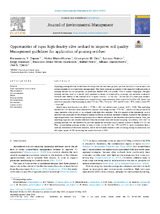Mostrar el registro sencillo del ítem
Opportunities of super high-density olive orchard to improve soil quality: Management guidelines for application of pruning residues
| dc.contributor.author | Taguas Ruiz, Encarnación | |
| dc.contributor.author | Marín-Moreno, Víctor | |
| dc.contributor.author | Díez, Concepción M. | |
| dc.contributor.author | Mateos, Luciano | |
| dc.contributor.author | Barranco Navero, Diego | |
| dc.contributor.author | Mesas Carrascosa, Francisco Javier | |
| dc.contributor.author | Pérez, Rafael | |
| dc.contributor.author | García-Ferrer Porras, Alfonso | |
| dc.contributor.author | Quero, José L. | |
| dc.date.accessioned | 2021-07-19T09:43:58Z | |
| dc.date.available | 2021-07-19T09:43:58Z | |
| dc.date.issued | 2021 | |
| dc.identifier.uri | http://hdl.handle.net/10396/21488 | |
| dc.description.abstract | Applying pruning residues in the lanes of olive groves has become a popular practice because it is economical and accrues benefits for soil and water management. This study presents an analysis of the impact of different rates of pruning residue on soil properties, in particular related with soil quality. Over 4 annual campaigns, chopped pruning residues used as a mulch were analyzed in terms of composition, coverage and moisture content to evaluate their effects on the amount of soil organic carbon (−10 cm and −20 cm) and CO2 emissions, temperature and moisture. The experiment was carried out in a super-intensive olive orchard in Cordoba (SE, Spain) and used four amounts of fresh pruning residue: 7.5 t ha⁻1(T1), 15.0 t ha⁻1 (T2) and 30.0 t ha⁻1 (T3), with a control T0 = 0.0 t ha1.Mulch mean leaf fraction was 46.0 ± 17.5% (±SD) and initial water content, 24.8 ± 8.6%. The mulching benefits for soil moisture were observed in amounts of pruning residue >7.5 t ha⁻1, which are only produced in super-intensive olive groves or in orchards with high tree densities. The low impact of the treatments on soil moisture was explained by the dramatic annual variations in residue moisture contents, caused by the regimes of high temperatures and rainfall-evapotranspiration deficits inherent to the Mediterranean Basin climate. Thus, the mulching capacity only resulted efficient when the residues were still humid in spring. In addition, 15.0 t ha⁻1 of pruning residues was the threshold to provide significant increases in soil organic carbon at depths of 0–20 cm. Thus, accumulating pruning residue in lanes at rates of over 15 t ha⁻1 (T2 and T3) is more convenient than a uniform distribution with lower amounts, due to the low mineralization rates occurring during warm seasons and the larger inputs of OM increasing the annual balance of SOC. | es_ES |
| dc.format.mimetype | application/pdf | es_ES |
| dc.language.iso | eng | es_ES |
| dc.publisher | Elsevier | es_ES |
| dc.rights | https://creativecommons.org/licenses/by-nc-nd/4.0/ | es_ES |
| dc.source | Journal of Environmental Management 293, 112785 (2021) | es_ES |
| dc.subject | Super high-density olive orchard | es_ES |
| dc.subject | Olea europaea L. | es_ES |
| dc.subject | Soil management | es_ES |
| dc.subject | Mulch | es_ES |
| dc.subject | Pruning residues | es_ES |
| dc.subject | Soil temperature | es_ES |
| dc.subject | Soil moisture | es_ES |
| dc.subject | Organic carbon | es_ES |
| dc.subject | Soil respiration | es_ES |
| dc.title | Opportunities of super high-density olive orchard to improve soil quality: Management guidelines for application of pruning residues | es_ES |
| dc.type | info:eu-repo/semantics/article | es_ES |
| dc.relation.publisherversion | http://dx.doi.org/10.1016/j.jenvman.2021.112785 | es_ES |
| dc.relation.projectID | Gobierno de España. CGL 2015-64284-C2-2-R | es_ES |
| dc.rights.accessRights | info:eu-repo/semantics/openAccess | es_ES |

